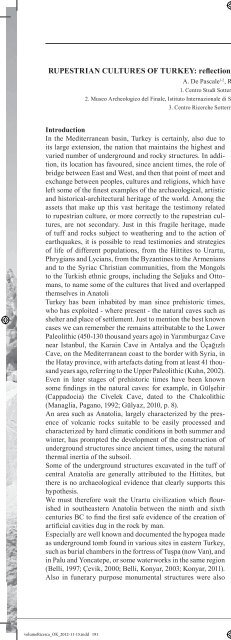habitat rupestre.pdf - Società Friulana di Archeologia
habitat rupestre.pdf - Società Friulana di Archeologia
habitat rupestre.pdf - Società Friulana di Archeologia
You also want an ePaper? Increase the reach of your titles
YUMPU automatically turns print PDFs into web optimized ePapers that Google loves.
RUPESTRIAN CULTURES OF TURKEY: reflections on the analysis and classification of a fragile heritageA. De Pascale 1-2 , R. Bixio 1 , V. Caloi 31. Centro Stu<strong>di</strong> Sotterranei - Genova (Italy)2. Museo Archeologico del Finale, Istituto Internazionale <strong>di</strong> Stu<strong>di</strong> Liguri sez. Finalese - Finale Ligure Borgo, Savona (Italy)3. Centro Ricerche Sotterranee Egeria - Roma (Italy)IntroductionIn the Me<strong>di</strong>terranean basin, Turkey is certainly, also due toits large extension, the nation that maintains the highest andvaried number of underground and rocky structures. In ad<strong>di</strong>tion,its location has favoured, since ancient times, the role ofbridge between East and West, and then that point of meet andexchange between peoples, cultures and religions, which haveleft some of the finest examples of the archaeological, artisticand historical-architectural heritage of the world. Among theassets that make up this vast heritage the testimony relatedto rupestrian culture, or more correctly to the rupestrian cultures,are not secondary. Just in this fragile heritage, madeof tuff and rocks subject to weathering and to the action ofearthquakes, it is possible to read testimonies and strategiesof life of <strong>di</strong>fferent populations, from the Hittites to Urartu,Phrygians and Lycians, from the Byzantines to the Armeniansand to the Syriac Christian communities, from the Mongolsto the Turkish ethnic groups, inclu<strong>di</strong>ng the Seljuks and Ottomans,to name some of the cultures that lived and overlappedthemselves in AnatoliTurkey has been inhabited by man since prehistoric times,who has exploited - where present - the natural caves such asshelter and place of settlement. Just to mention the best knowncases we can remember the remains attributable to the LowerPaleolithic (450-130 thousand years ago) in Yarımburgaz Cavenear Istanbul, the Karain Cave in Antalya and the ÜçağızlıCave, on the Me<strong>di</strong>terranean coast to the border with Syria, inthe Hatay province, with artefacts dating from at least 41 thousandyears ago, referring to the Upper Paleolithic (Kuhn, 2002).Even in later stages of prehistoric times have been knownsome fin<strong>di</strong>ngs in the natural caves: for example, in Gülşehir(Cappadocia) the Civelek Cave, dated to the Chalcolithic(Managlia, Pagano, 1992; Gülyaz, 2010, p. 8).An area such as Anatolia, largely characterized by the presenceof volcanic rocks suitable to be easily processed andcharacterized by hard climatic con<strong>di</strong>tions in both summer andwinter, has prompted the development of the construction ofunderground structures since ancient times, using the naturalthermal inertia of the subsoil.Some of the underground structures excavated in the tuff ofcentral Anatolia are generally attributed to the Hittites, butthere is no archaeological evidence that clearly supports thishypothesis.We must therefore wait the Urartu civilization which flourishe<strong>di</strong>n southeastern Anatolia between the ninth and sixthcenturies BC to find the first safe evidence of the creation ofartificial cavities dug in the rock by man.Especially are well known and documented the hypogea madeas underground tomb found in various sites in eastern Turkey,such as burial chambers in the fortress of Tuşpa (now Van), an<strong>di</strong>n Palu and Yoncatepe, or some waterworks in the same region(Belli, 1997; Çevik, 2000; Belli, Konyar, 2003; Konyar, 2011).Also in funerary purpose monumental structures were alsomade in ancient Phrygia (Midas şehri - Eskişehir, AyaziniAfyonkarahisar and Kütahya in western Anatolia) from theeighth century BC and in Lycia (Kaunos - Dalyan, Myra,Termessos e Tlos - in Antalya, in south-western Anatolia), atleast from the fifth century BC (De Francovich, 1990). Themost ancient quote clearly referable to underground structuresused as house (probably in the region of Kars in northeast Turkey),dates from the fourth century BC (Senofonte, libro IV,cap. V, par. 25-28, pp. 206-207).Of course, while still aware that much research on the rupestrianheritage of Turkey will must be carry out before toachieve safe dating and to a proper understan<strong>di</strong>ng and analysisof the rupestrian phenomenon, we can be said with certaintythat the moment of maximum flowering occurred in <strong>di</strong>fferentAnatolia regions during the Middle Ages.From hundreds of cavities in the subsoil of Ani - the ancientcapital of Armenia - and in the surroun<strong>di</strong>ng valleys, today inTurkish territory in the <strong>di</strong>strict of Kars (Bixio et al., 2009), tothose recently surveyed in the inland of Ahlat in the northwestshore of Lake Van (Bixio, De Pascale, 2011; De Pascale, Bixio,2011). From the numerous monastic complexes of Tur‘Ab<strong>di</strong>n, aplateau located at the south-eastern borders of Turkey (Mar<strong>di</strong>n<strong>di</strong>strict) considered the historical heart of Syriac Christianity(Johnson, 2007; Camplani, 2011; Chialà, 2011), to the thousandsof churches, monasteries, shelters, villages and entirecities carved into rocky cliffs and underground in Cappadocia(Bixio R., Castellani V., Succhiarelli C., 2002; Jolivet-Lévy,2001; Rodley, 2010). Not to mention villages and churches inthe provinces of Konya and Ankara (De Pascale, 2010), thoseof Ayazini Köyü (Afyonkarahisar) and in general the FrigVa<strong>di</strong>si, where are also found the Phrygian tombs previouslymentioned, or the structures of Hasankeyf (Batman) in southeasternTurkey.Just Cappadocia is the historical region that today still keepsone, if not more, impressive and extensive testimony of theFig. 1a Schematic geologic structure of Cappadocia (drawing R. Bixio)191volumeRicerca_OK_2012-11-15.indd 191 16/11/2012 15:03:17
















